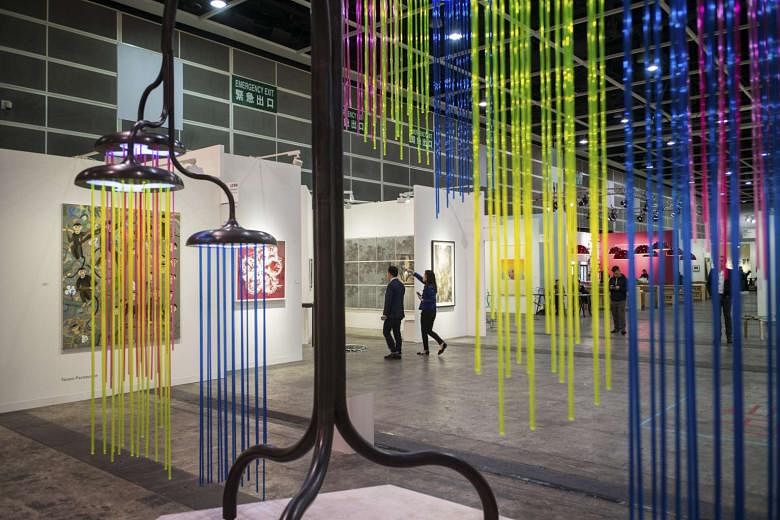HONG KONG • The first floor of the Hong Kong Convention and Exhibition Centre was already bustling when Mr Lin Han arrived at the opening of Art Basel Hong Kong, Asia's most important art fair.
In the three years since they began buying art, Mr Lin, a Beijing-based collector, and his wife, Ms Lei Wanwan, both 28, have built up a collection at lightning speed, acquiring more than 300 works. But at the VIP preview of the Hong Kong art fair last Tuesday, neither was in the mood to make any quick decisions.
Indeed, some dealers noted that the overall atmosphere seemed more muted than last year's, with fewer collectors in attendance, especially from Europe and North America, and less frenzied first-day buying - not entirely unexpected, given the recent economic slowdown in China.
"We just bought a few works at Tefaf, so we are not rushed to buy anything here," Mr Lin said, referring to the European Fine Art Fair this month in the Dutch town Maastricht. Instead, he and Ms Lei were more interested in browsing booths and promoting M Woods, their contemporary art museum in the 798 Art District of Beijing.
By the end of last Friday though, some dealers were reporting strong sales. Mr David Zwirner, who is planning to open a gallery in Asia, presented a booth of mostly figurative paintings, including five works by Michael Borremans made especially for the fair. All five were bought by Asian collectors, including the Long Museum in Shanghai, at prices ranging from US$250,000 (S$343,075) to US$1.6 million.
Leo Xu Projects, a Shanghai gallery, reported that it had sold eight works by Chinese artist Cui Jie for between US$7,700 and US$28,000 in the first 30 minutes of the VIP preview.
Mr Lin is one of a number of rising young collectors from mainland China, a group that dealers describe as motivated, well informed and more adventurous in taste than the older generation of Chinese collectors.
"The younger mainland Chinese collectors may have a reverence for the blue-chip, heavyweight Western contemporary artists," said Mr Nick Simunovic, managing director of Gagosian Gallery Hong Kong. "But they are also actively seeking out work which you might not have imagined mainland Chinese collectors pursuing five years ago."
Some dealers note that younger Chinese collectors lack the buying power of their elders. But although they may not be setting auction records with their purchases, many are exploring and collecting lesser- known artists. And unlike their older counterparts, they are more likely to have spent time abroad. As a result, dealers say, many are less concerned with nationality and feel more comfortable buying works by non-Chinese artists.
Mr Lin's personal collection, for example, includes works by Tracey Emin and John Currin, but also less established artists such as Richard Lin, Ouyang Chun, Firenze Lai and Charles Harlan. Recently, Mr Lin and Ms Lei, who earned a graduate degree in arts administration at Columbia University, have taken a keen interest in old masters.
That eclecticism was on display last Tuesday when Mr Lin homed in on several works by architect and artist Bijoy Jain at the booth of the gallery Chemould Prescott Road, of Mumbai, India.
"This feels fresh to me," he said as he leaned in to inspect one work, a pigment trace on cement of a ceremonial building in India.
It was the closest he came to buying anything on Tuesday. For the next four hours, he, Ms Lei and Ms Presca Ahn, the American director of their museum, merely took in the show.
The recent slowdown of the Chinese economy appears to have put a damper on art buying by all mainland collectors, regardless of their age. Total sales in the Chinese market dropped 23 per cent, to US$11.8 billion last year, according to the Tefaf report. And Britain supplanted China as the second-largest market for art sales last year, after the United States.
While dealers say the economic slowdown has been most acutely felt by the auction houses, the final results from Art Basel Hong Kong are still being looked to as an important measure of the state of the art market in Asia.
On the whole, there was a sense among dealers and collectors that the quality of the works at the Hong Kong fair, which this year included 239 galleries, was stronger than in previous years.
Highlights among Western galleries included Hauser & Wirth, which brought Spider Couple, a mammoth bronze Louise Bourgeois sculpture from 2003, and Alexander Calder's 1967 mobile Morning Cobweb. Marianne Boesky Gallery presented a solo exhibition of Frank Stella, including a 4m-tall wooden star.
Hauser & Wirth said it was in talks with an Asian museum about the Bourgeois sculpture. The gallery sold a number of works, including a Mark Bradford painting for US$1.5 million, as well as an Alexander Calder painting for an undisclosed amount.
"We decided to bring a different kind of booth this year, big pieces centred around the theme 'spider', so we were expecting this year to be more about education than sales," said Mr Neil Wenman, senior director at Hauser & Wirth in London. "But we are very happy about the sales too. We were able to connect with a different level of collector in Asia."
NEW YORK TIMES

